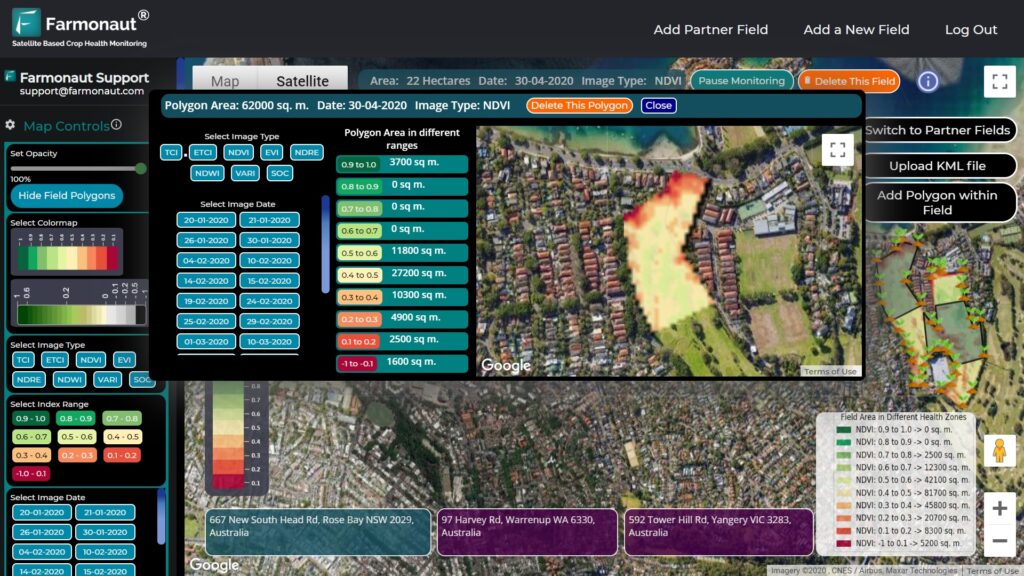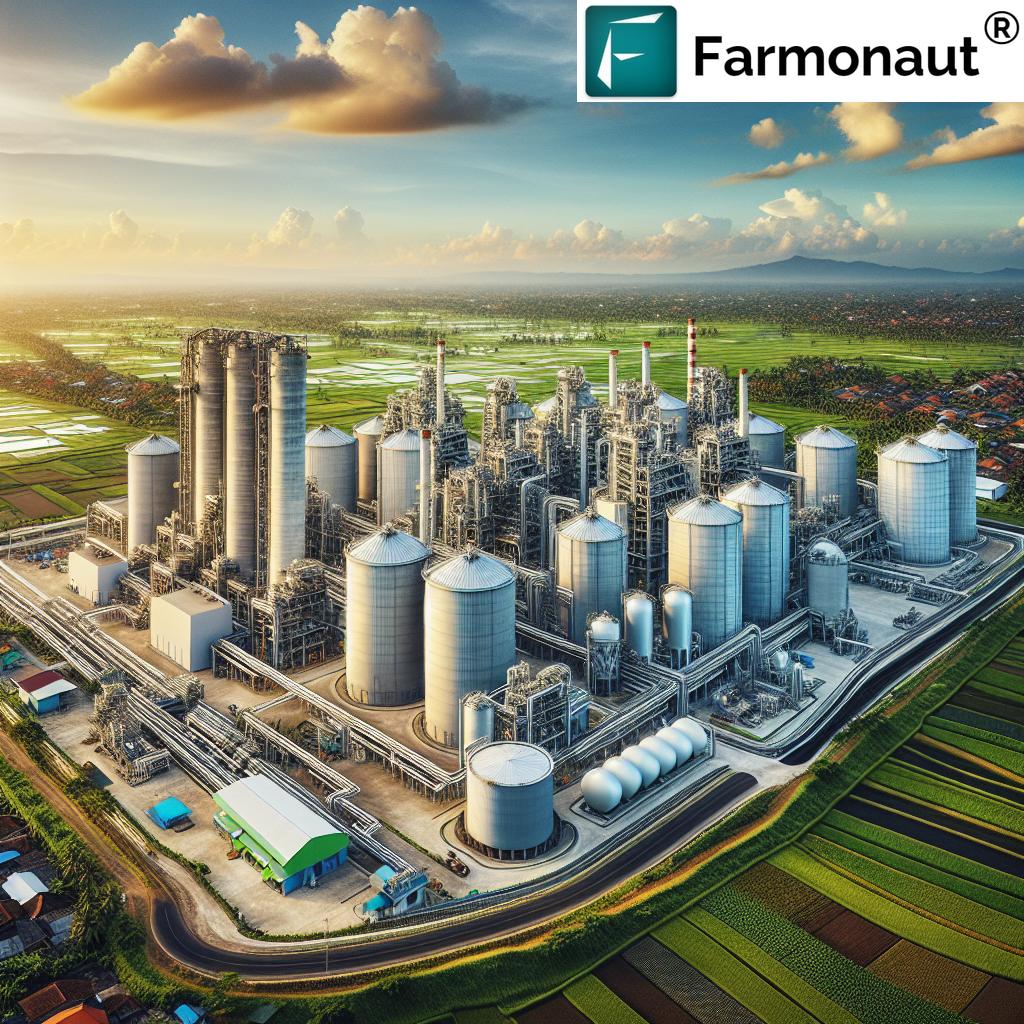Best Stocks in Agriculture Sector: India 2025 Guide — Navigating Tariffs, Inflation & Investment Trends
“In 2023, US tariffs contributed to a 12% rise in input costs for top Indian agriculture stocks.”
“Indian agriculture sector stocks saw a 9% volatility spike in 2024 due to global inflation trends.”
Table of Contents
- Introduction: Agriculture Sector Stocks in India — Context for 2025
- Impact of US Tariffs on Agriculture Stocks
- How Inflation Affects Agriculture and Related Stocks
- Agriculture Sector Stocks in India: Current Landscape & Best Picks for 2025
- Comparative Impact Table: Agriculture Stocks & Macroeconomic Factors 2025
- Emerging Sector Trends Shaping Agriculture Stocks in 2025
- Satellite Technology, Supply Chain Monitoring & The Role of Farmonaut
- Global Market Forces: How US Tariffs and Inflation Shift Investment Patterns
- Investment Strategies for Agriculture Sector Stocks in India (2025 & Beyond)
- FAQ: Best Stocks in Agriculture Sector & Key Investment Concerns
- Conclusion: Assessing the Future Outlook of India’s Agricultural Stocks
Introduction: Agriculture Sector Stocks in India — Context for 2025
The agriculture sector plays a vital role in India’s broader economy, contributing significantly to GDP, employment, and livelihoods across rural landscapes. With over half of India’s population depending on agricultural and allied activities, the sector directly and indirectly supports millions of households. As we progress into 2025, enhanced scrutiny surrounds agriculture sector stocks in India due to shifting macroeconomic forces—namely, US tariffs and global inflation. Investors, policy makers, and stakeholders alike are monitoring the impact of these variables on prices, supply chains, production, and investment decisions.
The key focus for 2025: how are stocks in agriculture sector affected by US tariffs and inflation? Understanding the dynamics behind market trends, cost structures, and investment opportunities is paramount for making informed decisions and assessing the future outlook of India’s agricultural industry.
Impact of US Tariffs on Agriculture Stocks in India
Over the past few years, the imposition of US tariffs on global agricultural commodities has significantly altered trade dynamics. These duties have:
- Affected trade flows in key commodities like soybeans, pulses, and edible oils.
- Promoted volatility in global commodity prices.
- Disrupted traditional supply chains and shifted international sourcing patterns.
- Created uncertainty for companies involved in both exports and imports—squeezing their margins.
India, as both a major exporter of certain crops and a significant importer for others (notably edible oils and pulses), faces direct and indirect consequences due to these global trade policies. For instance, US-imposed tariffs on Brazilian soybeans or Chinese products prompt global shifts in demand, which can make Indian exports less competitive or force domestic importers to seek costlier suppliers.
Additionally, retaliatory tariffs from affected countries exacerbate global price fluctuation, risk, and unpredictability. This volatility is reflected in the stock performance of Indian agrochemical, fertilizer, and processing companies like Coromandel International, UPL Limited, and Chambal Fertilizers—all of which are sensitive to the evolving trade environment.
Key Takeaways:
- US tariffs trigger higher input costs and reduced export demand for Indian companies.
- Supply chains for commodities like pulses, edible oils, and soybeans are disrupted, affecting companies reliant on imported inputs.
- Tariff-driven volatility leads to fluctuating stock prices and margins, particularly in fertilizer, agrochemicals, and food processing segments.
- Investors must closely monitor trade policies, as they directly influence investment decisions in the agriculture sector stocks in India.
Examples of Stocks in Agriculture Sector Affected by US Tariffs and Inflation:
- UPL Limited: As a company with global operations in agrochemicals, UPL faces cost pressures and changing trade flow patterns due to tariffs.
- Coromandel International: Dependent on both exports and imports of fertilizer inputs, Coromandel is sensitive to global trade disruptions.
- Bajaj Agro: With a focus on processing and distribution of edible oils and pulses, international tariffs and shifting global supplies affect input costs and margin realization.
How Inflation Affects Agriculture and Related Stocks
How does inflation affect agriculture? Inflation introduces a dual-edged risk for the agriculture sector in India:
-
On the cost side:
- Input costs (seeds, fertilizers, fuel, labor) increase, squeezing farmer margins.
- Wages rise, especially for rural and seasonal labor critical in India’s crop cycles.
- Higher transportation and logistics costs trickle down to every link of the supply chain.
-
On the revenue side:
- Inflation in end-product food prices can benefit firms in food processing, distribution, and warehousing, as they typically pass increased costs onto consumers—sometimes even improving their margins.
- But persistent inflation can reduce rural consumption of non-essential agricultural products, shrinking market opportunities.
In 2025, with global inflationary pressures still pronounced, Indian agriculture companies must navigate both cost escalation and opportunities for price-driven margin enhancement. Fertilizer, seed, and logistics firms are often most exposed to rising input costs, whereas food processing leaders may benefit from price inflation, provided demand remains robust.
Investor Implications: Thorough evaluation of company-specific risk exposure to rising input costs and their ability to pass on increased prices to end consumers is vital for stock selection in the agriculture sector stocks in India for 2025.
Examples of Inflation’s Effects:
- Fertilizer companies (Coromandel International, Chambal Fertilizers): Face compound pressures from rising prices of imported phosphates, potash, and fuel.
- Food processing firms (Bajaj Agro): May benefit as edible oil and pulse prices respond to inflation, but persistent high prices may limit demand growth.
- Seed and Agri-input firms: Must carefully manage price pass-through to sustain farmer demand, especially during prolonged inflationary cycles.
Agriculture Sector Stocks in India: Current Landscape & Best Picks for 2025
The landscape of agriculture sector stocks in India encompasses a diverse array of companies spanning fertilizers, seeds, agrochemicals, food processing, supply chain logistics, farm equipment, and agri-tech platforms. For 2025 and beyond, analysts recommend targeting:
- Resilient companies with diversified supply chains
- Leaders in innovation and input efficiency
- Export-oriented firms able to navigate global volatility
Let’s review the best stocks in agriculture sector to watch in India for 2025, focusing on segments most affected by US tariffs and inflation.
Top Agriculture Stocks in India for 2025
-
UPL Limited (Agrochemicals & Specialty Inputs)
- One of the largest global crop-protection companies.
- Benefits from global presence—allowing navigation of tariffs across markets.
- Strong focus on innovation: specialty crop protection, sustainability, and digital farming solutions.
Read about how digital and AI-driven tools shape this segment: Explore Farmonaut’s Carbon Footprinting Solutions for agriculture supply chains. - Challenges: Vulnerability to currency risk, global commodity price swings, and input cost hikes in inflationary environments.
-
Coromandel International (Fertilizers & Crop Protection)
- Industry leader in complex and phosphatic fertilizers with a robust distribution network across rural India.
- Enhances efficiency, reduces import dependency, and adopts technology for resource management.
- Strategic use of satellite insights and AI for farm advisory – see how Farmonaut’s tech powers smarter farming and resource management in India:
Satellite-Driven Crop Plantation & Forest Advisory - Resilient to trade disruptions due to diversified input sourcing but closely impacted by global commodity cycles and inflation.
-
PI Industries (Agrochemicals & Specialty Intermediates)
- Reputation for R&D and product innovation in rapidly changing regulatory environments.
- Well-positioned to benefit from global market shifts and rising domestic demand for specialty agri-inputs.
- Keeps margins healthy via product customization and responsive supply chain management.
-
Bajaj Agro (Agri-processing, Edible Oils, Pulses)
- Major processor of edible oils and pulses for domestic and export markets.
- Benefits from rising domestic prices but exposed to input cost fluctuations and trade volatility.
- Leverages strong distribution for margin stability amid inflationary cycles.
Want to experience real-time agriculture monitoring and satellite insights?



Comparative Impact Table:
Agriculture Sector Stocks vs. US Tariffs & Inflation (2025 Estimates)
| Stock Name | Sector Segment | Estimated 2025 Price (INR) | Impact of US Tariffs | Impact of Inflation | Investment Outlook (2025) |
|---|---|---|---|---|---|
| UPL Limited | Agrochemicals/Specialty Inputs | 760-810 | Neutral/Negative (exposed to global trade shifts) |
High (costly inputs, margin pressure) |
Bullish (if able to pass costs, diversify exports) |
| Coromandel International | Fertilizers/Crop Protection | 1,160-1,240 | Moderate/Neutral (india-centric sourcing) |
Moderate (imported fertilizer costs rising) |
Stable to Bullish (efficiency & demand resilience) |
| PI Industries | Agrochemicals | 3,580-3,730 | Neutral (domestic orientation, specialty focus) |
Moderate (input costs, strong product mix) |
Bullish (innovation-led) |
| Bajaj Agro | Agri-processing / Edible Oils / Pulses | 410-480 | Negative (heavily reliant on edible oil imports) |
High (margins squeezed by volatile input prices) |
Stable (niche segments, domestic demand) |
| Chambal Fertilizers | Fertilizers | 360-415 | Negative (input import dependency) |
High (urea/energy costs volatile) |
Bearish to Stable (cost pass-through challenges) |
| Kaveri Seed | Seeds/Agri-inputs | 600-655 | Neutral (domestic focus) |
Moderate (input inflation risk, demand stable) |
Stable (innovation, farm support) |
Emerging Sector Trends Shaping Agriculture Stocks in 2025
- Increasing input cost volatility due to global commodity cycles, energy prices, and trade policies.
- Technology adoption & digital supply chains are on the rise, enabling cost control and transparency.
- Satellite-based real-time monitoring is being used for resource optimization and environmental tracking.
- AI/Blockchain-based traceability is helping companies and investors assure provenance, quality, and compliance in agriculture outputs.
Want to see how blockchain ensures safe agrifood trade? Farmonaut’s Blockchain Traceability Platform lets enterprises verify product journeys for transparency and trust. - Supply chain de-risking—companies diversify sourcing, regionalize production, and deepen engagement with rural and semi-urban supply bases.
- Environmental stewardship—with carbon footprint disclosures and sustainable production practices coming to the fore, in part due to international trade pressures.
Satellite Technology, Supply Chain Monitoring & The Role of Farmonaut
As tariffs and inflation reshape global agricultural trade, the adoption of advanced technologies becomes a non-negotiable advantage. Satellite data, AI-powered insights, and blockchain traceability are among the solutions positioning companies and investors to navigate 2025’s risks/opportunities.
- Satellite-Based Monitoring: Enables farms, processors, and distributors to track crop health, input usage, and environmental impacts in real time.
- AI-Driven Farm Advisory: Helps farmers and agri-businesses optimize decisions amid price/inflation uncertainty.
- Blockchain Traceability: Provides secure, transparent supply chain validation for exports and processed agri-products.
-
Fleet & Resource Management: Reduces transport/logistics costs—a critical advantage in times of commodity price swings.
Explore fleet tracking and resource optimization for agricultural businesses: Farmonaut’s Fleet Management Platform - Environmental Monitoring: Empowers compliance and ESG initiatives by providing real-time carbon emission and land use analytics.
Whether you are an individual farmer, corporate agri-business, government, or financial institution, using Farmonaut’s API (API for developers and Developer Docs) enables you to integrate satellite intelligence for better decision making.
Enterprises can reduce crop loss, manage inputs, and monitor impact, all while building future-ready operations as agriculture sector stocks in India become increasingly sensitive to macroeconomic forces in 2025 and beyond.
Global Market Forces: How US Tariffs and Inflation Shift Investment Patterns
The combination of tariffs and inflation creates new risk/return equations for agriculture sector stocks in India. Let’s break down some of the most important market trends shaping 2025’s stock valuations and investor decisions:
- Supply Chain Resilience: Companies with global linkages and diversified input sourcing offset trade volatility more effectively.
- Technology Adoption: Artificial intelligence, satellite monitoring and traceability improve operational efficiency, reducing inflationary impacts and enhancing transparency.
- Consumer Demand Behavior: Persistent food price inflation boosts revenue for processing companies, but can also dent rural demand for “premium” agri-products.
- Currency Fluctuation: As a side-effect of global policy shifts, exchange-rate risks have a direct impact on exporters and importers of crops, agrochemicals, and fertilizer inputs.
-
ESG & Sustainability: Regulatory shifts (like mandatory carbon footprint disclosures for exporters) incentivize smarter technology adoption and favor companies with strong sustainability practices.
See how remote carbon reporting empowers sustainable agriculture: Farmonaut’s Carbon Footprinting Solutions
Investment Strategies for Agriculture Sector Stocks in India (2025 & Beyond)
How can investors make informed decisions about the best stocks in agriculture sector for 2025?
- Monitor Macroeconomic Indicators: Track inflation, US trade policies, agro input price trends, and government policies impacting the sector.
- Prioritize Diversified Companies: Those with robust export markets, strong domestic brands, and flexible supply chain strategies (like UPL and Coromandel) tend to absorb shocks better.
- Evaluate Technology Adoption: Firms actively leveraging AI, satellite, and blockchain are more likely to maintain margins and ensure transparency.
- Understand Product Mix: Agrochemical or seed firms exposed to volatile energy/chemical costs may see margin pressure, whereas food processors could gain from rising prices, provided volume stability.
-
Leverage Real-time Monitoring: Investors and stakeholders can use satellite-led monitoring solutions for data-driven evaluations of crop cycles, yield trends, and supply disruptions.
Reference: Farmonaut Large Scale Farm Management Tool supports enterprise-grade agriculture analytics – critical for investment due diligence. - Risk Management: Monitor exposure to international commodity cycles and ensure diversification across segments (seeds, inputs, processing, logistics).
-
Plan for Sustainable Finance: With new regulations, banks and insurers increasingly require satellite-driven verification and risk mapping.
Explore satellite verification for crop loans and insurance: Farmonaut Crop Loan & Insurance
Farmonaut Subscription Options for Agriculture Stakeholders
FAQ: Best Stocks in Agriculture Sector, Tariffs, Inflation, and Investment in India (2025)
Q1: Which stocks in agriculture sector are most affected by US tariffs and inflation?
UPL Limited, Coromandel International, Chambal Fertilizers and major firms in agrochemicals, fertilizers, and food processing are impacted the most. Their global sourcing and export focus make them sensitive to trade policy shifts and raw material cost rises.
Q2: How does inflation affect agriculture stock performance for investors?
Inflation raises the cost of inputs; companies that pass these on to consumers or innovate to lower production cost fare the best. Food processors can benefit from price rises if demand remains stable.
Q3: What are the main risks for agriculture sector stocks in 2025?
Key risks include input cost escalation, trade policy volatility, unpredictable demand due to persistent inflation, supply disruption (from geopolitics or weather) and regulatory changes (like stricter ESG norms).
Q4: How can technology support stakeholders and investors in the agricultural industry?
Adopting satellite-based, AI-enabled and blockchain-backed platforms enables real-time risk management, supply chain transparency, and precision resource allocation—critical for navigating volatility.
Q5: Are food processing companies safer investments than input suppliers (like fertilizers, seeds)?
Not necessarily; while food processors may capitalize on rising end-product prices, persistent inflation could deter demand. Input suppliers with strong innovation and diversified sourcing may adapt better to shocks.
Q6: How do Farmonaut’s solutions add value for market stakeholders?
Farmonaut provides real-time, affordable satellite insights for agriculture, enabling data-driven farm management, input optimization, supply chain monitoring, blockchain traceability, and impact tracking—empowering nimble, informed decisions in volatile markets.
Conclusion: Assessing the Future Outlook of India’s Agricultural Stocks (2025 & Beyond)
The best stocks in agriculture sector for India in 2025 offer both remarkable growth opportunity and unique risk exposure—particularly as the landscape is continuously shaped by US tariffs, inflation, global trade policies, and domestic reforms. While inflation poses significant cost challenges for farmers and input providers, certain segments—especially those engaged in food processing and logistics—may capitalize on their pricing power.
Key investor action points for 2025:
- Identify companies with diversified, robust supply chains and strong export portfolios.
- Prioritize investment in stocks with high innovation potential—especially those using satellite, AI, and blockchain technologies.
- Consistently monitor macroeconomic trends, trade flows, policy reforms, and global commodity prices.
- Stay agile—risk/reward equations shift rapidly in response to policy changes and price cycles.
As we collectively navigate unprecedented macroeconomic volatility, adopting technology, data-driven platforms, and forward-thinking risk management will be crucial for all stakeholders in India’s agriculture sector stocks. Investing in knowledge, real-time insights, and scalable digital systems will remain paramount for both resilience and prosperity well beyond 2025.
Want to unlock actionable insights for farm, business, or investment strategy?











